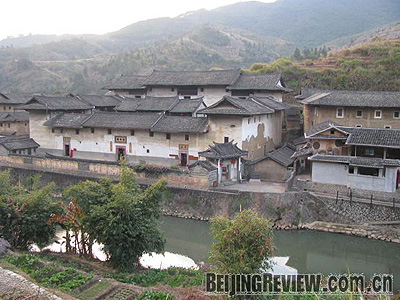| The Hongkeng Hakka Tulou Village is a self-contained tulou wonderland in Yongding County in southwestern Fujian Province. It affords visitors an opportunity to explore a few earthen roundhouses and a cultural museum and spend the night in an earthen building. It takes several hours to reach by bus or minivan from the port city of Xiamen. Because the tourism infrastructure here is minimal and hardly any English is spoken, there are no hordes of visitors or large motor coaches.
 |
|
BIRDS EYE VIEW: The Fuyu Building Changdi Inn is a five-phoenix-shaped tulou hotel whose roofs resemble the mythical bird in flight (ROSEANNE GERIN) | Accommodations are basic at the Fuyu Building Changdi Inn, a five-phoenix-shaped tulou hotel, which resembles the mythical bird in flight with the heights of the roofs on its various rooms increasing by different degrees. The central courtyard houses two communal showers in an enclosed area. The only furniture in the small rooms is a bed or two and a chair, but surprisingly also televisions and a colorful flashing night light to enhance any romantic encounters.
Tulou are supposed to be warm in winter, because their earthen walls usually retain heat during the chilly months, and cool in summer. A wooden shutter in my room covered the small window facing the outside, while a sliding shutter covered the larger front window that overlooked the inner courtyard. Nevertheless, I was still chilly in bed even with two heavy quilts.
It was fairly quiet until the next morning when some locals set off firecrackers at 6:20 a.m. and 7:15 a.m. as an unwelcome wake-up call. Later our local guide informed us that firecrackers are set off to honor Buddha on the first and 15th days of each month of the lunar calendar.
From above, the large Hakka earthen roundhouses in the remote hills and farmlands of Fujian look like invading UFOs in a B-grade alien thriller from the 1950s, or humongous mushrooms of Alice in Wonderland proportion. A popular local story has it that the U.S. military thought the structures, usually built in groups of two or three, were missile silos or nuclear reactors when they first detected them in satellite photos in the 1960s. A couple of spies were dispatched to investigate, but found the imposing buildings were merely huge communal dwellings, some dating back more than 1,000 years.
In the 1980s, academic researchers from Japan, and later Chinese academics, came to explore the structures and published reports about the fortified compounds as feats of civil engineering with their meters-thick, rammed-earth walls and individual water and sewage systems. As word got out, they became tourist attractions for both Chinese and foreign visitors, who now come to the area to marvel at some of the thousands of tulou. The architectural wonders got another boost last year when UNESCO added them to its list of world heritage sites.
The Hakkas, a word meaning "guest," were Han Chinese who had fled from invasions and upheavals in central China several times since the Jin Dynasty (265-420) and settled in the remote mountains of Fujian and a few other provinces. The most common tulou are two- to four-story roundhouses, although they are also built in ovals, squares, rectangles and ones that resembles phoenixes and other animals. Constructed mainly for defensive purposes, the structures have one main entrance and small windows only on the upper stories. Their walls are made of rammed earth containing yellow soil, glutinous rice, wood chips and bamboo. The sturdy fortifications can withstand earthquakes, powerful winds, fires and dampness.
A one- to two-centimeter steel sheet reinforces the main door. It is said that most tulou have a hidden escape route known only to a few who live inside. Residents occupy vertical units of rooms that are typically 10-15 square meters each with kitchen and dining areas on the ground floor, a storage area on the second floor, and sleeping quarters on the third and fourth floors. Wooden stairs and outer corridors connect each floor inside the tulou so that each family has a private staircase to their upper rooms. In some central courtyards are smaller rings of inner buildings or square multifunctional halls for schooling, worshipping Buddha and family ancestors, and holding funerals and community meetings. It is also where the names of newborns are decided and publicly announced on red paper and family problems are hashed out.
Except for the morning firecrackers during my stay in Hongkeng, life in all the Hakka villages I visited seemed tranquil and uneventful with no other forms of entertainment. The next day, I wandered around Chuxi Village after exploring the round four-story Jiqinglou, the oldest building in the tulou cluster here, which was constructed in the 15th century, and its Hakka culture museum.
A hospitable old man who crossed my path invited me to his place for tea. He offered me a seat at his small kitchen table along with a cigarette, which I declined, and some miniature bananas and mandarin oranges. As a couple of neighbors quietly wandered unannounced into his simple room to see his new acquaintance, the elderly man took a pencil and wrote something on the back of a candy wrapper and gave it to me. "Xie xie," I said as I folded the paper and stuck it in my sweater pocket, believing it contained his name along with some profound Chinese saying. The trio chuckled lightly.
When I had had my fill, I thanked my host, handed him a five-yuan note which he reluctantly accepted, and bade him farewell. It wasn't until much later after we had returned to Xiamen, that I remembered the wrapper. I showed it to our tour guide and eagerly awaited the translation of the old man's words of wisdom.
The guide read it nonchalantly, "Which country are you from?"
The author is an American who lives and works in Beijing |
